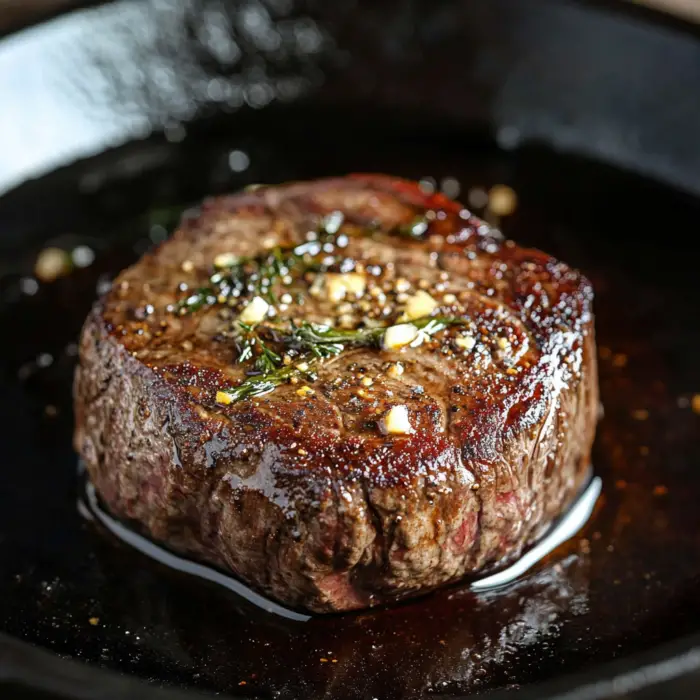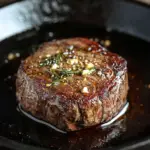Filet Mignon is one of the most tender and flavorful cuts of beef, and cooking it in a cast iron pan gives it an excellent sear and caramelization. Follow this simple recipe to create a mouth-watering steak dinner that’s worthy of a restaurant-quality meal right at home. Here’s how to cook filet mignon in a cast iron pan to perfection.

Ingredients for Cooking Filet Mignon
2 Filet Mignon steaks (approximately 1″ thick)
3 tablespoons of mild, high smoke-point oil (such as vegetable or canola oil)
A pinch of kosher or sea salt
2 tablespoons of unsalted butter
Fresh thyme or rosemary for added flavor

Step-by-Step Instructions
1. Prepare the Steaks
Before cooking, allow your filet mignon steaks to sit at room temperature for about 30 minutes. This helps them cook more evenly. After the steaks have warmed up, pat them dry with a paper towel and season generously with kosher or sea salt.
2. Preheat Your Oven
While the steaks rest, preheat your oven to 400°F (200°C). This will allow for a quick transition from the stovetop to the oven for perfect doneness.
3. Heat the Cast Iron Pan
Place your cast iron skillet over medium-high heat and add 3 tablespoons of oil. Let the oil heat up for 2-3 minutes until it’s shimmering and very hot, but not smoking.
4. Sear the Filet Mignon
Carefully place the steaks into the hot pan. Be cautious of oil splatter. Sear the first side for 2-3 minutes, or until a deep brown crust forms on the bottom. Flip the steaks and immediately add the 2 tablespoons of unsalted butter and a few sprigs of fresh thyme or rosemary to the pan.
5. Transfer to the Oven
Once you’ve flipped the steaks, turn off the burner and transfer the entire cast iron pan into the preheated oven.
6. Cook to Your Desired Doneness
Allow the steaks to cook in the oven for an additional 2-6 minutes, depending on your preferred doneness:
- Rare: 125-130°F
- Medium Rare: 135°F
- Medium: 140-145°F
- Medium Well: 155°F
- Well Done: 160-165°F
Pro Tips for Perfect Filet Mignon
- Use a meat thermometer to accurately gauge doneness.
- Letting the steaks come to room temperature ensures even cooking.
- Don’t forget to spoon the melted butter over the steaks while they rest for extra flavor.
Serving and Storage Tips for Filet Mignon
Serving Tips
- Pairing Suggestions: Filet mignon pairs beautifully with a variety of side dishes. Classic options include roasted vegetables, garlic mashed potatoes, or a fresh green salad. For a richer experience, serve with a red wine reduction sauce or a creamy peppercorn sauce.
- Wine Pairing: A full-bodied red wine like Cabernet Sauvignon, Merlot, or Pinot Noir complements the flavors of filet mignon perfectly.
- Garnishing: Top your filet mignon with freshly cracked black pepper, a sprinkle of sea salt, or a drizzle of truffle oil for an elevated presentation. Adding fresh herbs like thyme or rosemary also enhances the aroma and flavor.
- Resting Before Serving: Let the filet mignon rest for 5-10 minutes after cooking. This allows the juices to redistribute, ensuring a tender and juicy steak.
Storage Tips
- Refrigerating Leftovers: If you have leftover filet mignon, store it in an airtight container in the refrigerator. It will stay fresh for up to 3 days.
- Reheating: To retain the tenderness, reheat the filet mignon gently. You can use the oven at a low temperature (around 250°F) for about 10-15 minutes, or reheat in a skillet on low heat with a little butter. Avoid microwaving, as it can make the steak tough and overcooked.
- Freezing Filet Mignon: If you want to freeze cooked filet mignon, wrap it tightly in plastic wrap or aluminum foil and place it in a freezer-safe bag. It can be stored in the freezer for up to 3 months. Thaw it in the refrigerator overnight before reheating.
- Storing Uncooked Filet Mignon: If you don’t plan to cook the filet mignon right away, you can store raw steaks in the refrigerator for up to 2 days. For longer storage, wrap them well and freeze for up to 6 months.
Variations for Cooking Filet Mignon
While the classic filet mignon cooked in a cast iron pan is delicious, there are several ways to add variety and elevate the dish with different techniques and flavors. Here are some creative variations:
1. Garlic Butter Filet Mignon
- How to Make: For an extra burst of flavor, add minced garlic to the butter when searing the steaks. As the butter melts, the garlic will infuse the filet mignon with a rich, savory flavor. Baste the steaks with the garlic butter for a deliciously aromatic dish.
- Serving Suggestion: Serve with roasted garlic mashed potatoes or a side of sautéed spinach.
2. Herb-Crusted Filet Mignon
- How to Make: Create a flavorful herb crust by combining finely chopped rosemary, thyme, parsley, and garlic. Press the herb mixture onto the steaks before searing them in the pan. This adds an earthy, fragrant crust to the filet mignon.
- Serving Suggestion: Pair with a fresh herb butter or a light chimichurri sauce for extra flavor.
3. Bacon-Wrapped Filet Mignon
- How to Make: Wrap each filet mignon with a strip of bacon before cooking. Secure the bacon with toothpicks. The bacon adds a smoky, crispy exterior and keeps the steak extra juicy as it cooks.
- Serving Suggestion: Bacon-wrapped filet mignon pairs perfectly with a side of asparagus or green beans and a glass of red wine.
4. Peppercorn Crusted Filet Mignon
- How to Make: Coat the filet mignon with crushed black peppercorns before searing. This gives the steak a spicy, robust crust. For even more flavor, serve with a creamy peppercorn sauce made from heavy cream, beef stock, and crushed peppercorns.
- Serving Suggestion: Serve with roasted potatoes or a creamy mushroom sauce.
5. Blue Cheese Crusted Filet Mignon
- How to Make: After searing the filet mignon, top it with a mixture of blue cheese and breadcrumbs. Transfer to the oven and broil for a few minutes until the cheese melts and forms a golden crust. The tangy flavor of blue cheese complements the rich taste of the steak.
- Serving Suggestion: Serve with a crisp salad or roasted vegetables for balance.
6. Filet Mignon with Red Wine Reduction
- How to Make: After cooking the steaks, use the same pan to create a red wine reduction sauce. Add red wine, beef stock, and shallots to the pan, and reduce until thickened. Pour the sauce over the filet mignon for an elegant and flavorful dish.
- Serving Suggestion: Perfect alongside mashed potatoes or a buttery risotto.
7. Filet Mignon with Mushroom Sauce
- How to Make: Prepare a creamy mushroom sauce by sautéing mushrooms in butter with garlic, thyme, and shallots. Add heavy cream or beef broth to create a rich sauce to serve over the filet mignon.
- Serving Suggestion: Ideal with roasted root vegetables or a side of polenta.
8. Filet Mignon with Truffle Butter
- How to Make: Elevate the flavor with a luxurious touch by adding a dollop of truffle butter on top of the filet mignon just before serving. The rich, earthy taste of truffle perfectly complements the tender steak.
- Serving Suggestion: Best served with simple sides like sautéed green beans or a light arugula salad to let the truffle flavor shine.
Frequently Asked Questions (FAQs) About Cooking Filet Mignon
1. How do I know when my filet mignon is cooked to the right temperature?
- The best way to ensure your filet mignon is cooked to the perfect doneness is to use a meat thermometer. Insert the thermometer into the thickest part of the steak. The following are the temperature ranges for different levels of doneness:
- Rare: 125-130°F
- Medium Rare: 135°F
- Medium: 140-145°F
- Medium Well: 155°F
- Well Done: 160-165°F
2. Can I cook filet mignon without a cast iron pan?
- Yes, you can use any oven-safe skillet, such as stainless steel. However, cast iron is preferred because it retains heat well and gives the filet mignon a beautifully seared crust.
3. Do I need to let the filet mignon rest before cooking?
- Yes, it’s important to let your filet mignon come to room temperature for about 30 minutes before cooking. This helps ensure that the steak cooks evenly, resulting in a juicier, more tender filet.
4. Why is my filet mignon tough?
- Filet mignon can become tough if it’s overcooked or cooked at too high a heat for too long. To avoid this, monitor the internal temperature closely with a meat thermometer and use the oven to finish cooking rather than relying on high heat the entire time.
5. Can I marinate filet mignon?
- While filet mignon is tender and flavorful on its own, you can marinate it if you prefer added flavors. A simple marinade with olive oil, garlic, herbs, and a touch of acidity (like lemon juice or vinegar) works well. However, don’t marinate it for too long (no more than 30 minutes), as it may overpower the delicate flavor of the filet.
6. Should I use oil or butter when cooking filet mignon?
- It’s recommended to use oil with a high smoke point (like vegetable or canola oil) for searing because it can withstand the high heat needed to create a crust. Butter can be added during the last minute of searing or when the steak is transferred to the oven, as it imparts rich flavor without burning.

The Perfect Filet Mignon Recipe
Description
Filet Mignon is one of the most tender and flavorful cuts of beef, and cooking it in a cast iron pan gives it an excellent sear and caramelization. Follow this simple recipe to create a mouth-watering steak dinner that’s worthy of a restaurant-quality meal right at home. Here’s how to cook filet mignon in a cast iron pan to perfection.
Ingredients
2 Filet Mignon steaks (approximately 1″ thick)
3 tablespoons of mild, high smoke-point oil (such as vegetable or canola oil)
A pinch of kosher or sea salt
2 tablespoons of unsalted butter
Fresh thyme or rosemary for added flavor
Instructions
1. Prepare the Steaks
Before cooking, allow your filet mignon steaks to sit at room temperature for about 30 minutes. This helps them cook more evenly. After the steaks have warmed up, pat them dry with a paper towel and season generously with kosher or sea salt.
2. Preheat Your Oven
While the steaks rest, preheat your oven to 400°F (200°C). This will allow for a quick transition from the stovetop to the oven for perfect doneness.
3. Heat the Cast Iron Pan
Place your cast iron skillet over medium-high heat and add 3 tablespoons of oil. Let the oil heat up for 2-3 minutes until it’s shimmering and very hot, but not smoking.
4. Sear the Filet Mignon
Carefully place the steaks into the hot pan. Be cautious of oil splatter. Sear the first side for 2-3 minutes, or until a deep brown crust forms on the bottom. Flip the steaks and immediately add the 2 tablespoons of unsalted butter and a few sprigs of fresh thyme or rosemary to the pan.
5. Transfer to the Oven
Once you’ve flipped the steaks, turn off the burner and transfer the entire cast iron pan into the preheated oven.
6. Cook to Your Desired Doneness
Notes
Use a meat thermometer to accurately gauge doneness.
Letting the steaks come to room temperature ensures even cooking.
Don’t forget to spoon the melted butter over the steaks while they rest for extra flavor.
